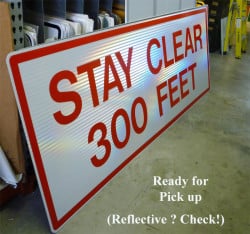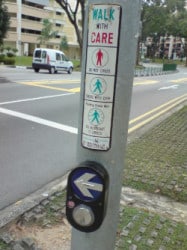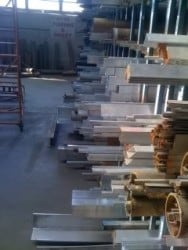Get to know reflective traffic sign sheeting, signposts. And, here’s the comparison of flat versus extruded aluminum materials.
Question: What is Reflective Sheeting?
Reflective sheeting is the sheeting used to create reflective road signs, traffic signs, street signs, and highway signs.
Basically, reflective sheeting is laminated to aluminum sign blanks of various sizes and shapes, then printed with whatever copy is needed, and you have a reflective traffic sign.
Different Reflective Sheet Grading
 Reflective sheeting comes in various grades, the most common being “Engineer Grade,” “Hi-Intensity Prismatic”, and “Diamond Grade.” The USDOT requires diamond grade for most interstate signs, and most state DOT’s require it for school zones and stop signs and any sign mandated to use it that they believe needs it. Those requirements vary from state to state.
Reflective sheeting comes in various grades, the most common being “Engineer Grade,” “Hi-Intensity Prismatic”, and “Diamond Grade.” The USDOT requires diamond grade for most interstate signs, and most state DOT’s require it for school zones and stop signs and any sign mandated to use it that they believe needs it. Those requirements vary from state to state.
“Engineer Grade” reflective sheeting is now used mostly for private company signs or decals and has less intense reflectivity than does the HIP or DG reflective sheeting. If you were to call up to order reflective decals from our firm, we’d be printing them on “EG” reflective films.
Question: What are traffic sign posts made of?
 That depends. Depends on whose jurisdiction the signs are in, for instance.
That depends. Depends on whose jurisdiction the signs are in, for instance.
If the sign is located on the Interstate Highway System, the USDOT works with the State DOT to determine how sign systems are constructed. The USDOT allows some variation in the way signs are posted.
Depending on Your Local Jurisdictions
In some jurisdictions, wood posts are used to post some types of signs, although wood seems to rarely be used for the big green and white wayfinding signs any more. Most of the time traffic sign posts are constructed of welded and/or bolted together steel frames, and even the smaller signs now, at least in our area, are mostly posted with steel posts.
However, I still see, in housing developments or commercial developments, that pressure-treated wood posts are allowed. I personally recommend the pre-punched galvanized steel posts and post sleeves over wood or the U-channel posts that are used by those trying to keep costs down.
Question: What’s the difference between a flat aluminum and an extruded aluminum street name sign?
Flat Aluminum Signs
 Flat aluminum is pretty self-explanatory and is easy to describe, so I’ll do that first. Flat aluminum is actually extruded as well, but it’s extruded into flat sheets, and most traffic control signs that are constructed of flat sheet aluminum range in thickness from .080” to .25”, although most of the time, in my experience, once the thickness moves past .125” with flat sheets, either a supporting frame buttresses the sign, or we use extruded aluminum.
Flat aluminum is pretty self-explanatory and is easy to describe, so I’ll do that first. Flat aluminum is actually extruded as well, but it’s extruded into flat sheets, and most traffic control signs that are constructed of flat sheet aluminum range in thickness from .080” to .25”, although most of the time, in my experience, once the thickness moves past .125” with flat sheets, either a supporting frame buttresses the sign, or we use extruded aluminum.
Extruded Aluminum Signs
Extruded aluminum signs are usually extruded in channel-shaped sections, sometimes with “ribs” that support the extrusion in high wind conditions. The extrusions are often “stacked” one on another and bolted together, then bolted to a galvanized steel framework that holds the whole sign together.
Stop signs, speed limit signs, school zone signs, Parking Signs, etc., are almost never extruded, but are flat panel signs. The extruded signs are usually used only for large wayfinding signs, like the ones on I-75 telling you how far it is to Atlanta, Georgia or Lexington, Kentucky, or I-90 telling you how far it is to Seattle, Washington.
Check this out for more about these road sign markers. You can leave any questions related to this topic in the comment form below and I’ll gladly answer them.
Popular Posts:




